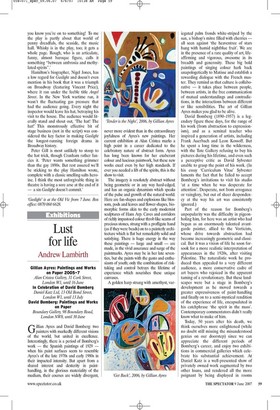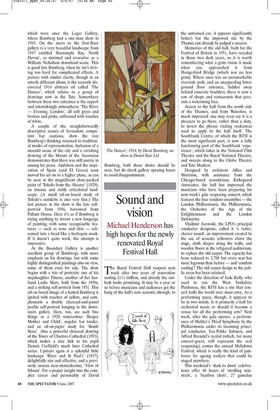Lust for life
Andrew Lambirth Gillian Ayres: Paintings and Works on Paper 2005-7 Alan Cristea Gallery, 31 Cork Street, London Wl, until 16 June In Celebration of David Bomberg Daniel Katz Ltd, 13 Old Bond Street, London Wl, until 13 July David Bomberg: Paintings and Works on Paper Boundary Gallery, 98 Boundary Road, London 1VW8, until 30 June Gillian Ayres and David Bomberg: two painters with markedly different visions of the world, but united in excellence. Interestingly, there is a period of Bomberg's work — the Spanish paintings of 1929 — when his paint surfaces seem to resemble Ayres's of the late 1970s and early 1980s in their impacted intensity. But apart from a shared interest and dexterity in painthandling, in the glorious materiality of the medium, their courses are widely divergent, never more evident than in the extraordinary joyfulness of Ayres's new paintings. Her current exhibition at Alan Cristea marks a high point in a career dedicated to the celebratory nature of abstract form. Ayres has long been known for her exuberant colour and luscious paintwork, but these new works excel even by her high standards. If ever you needed a lift of the spirits, this is the show to visit.
The imagery is resolutely abstract without being geometric or in any way hard-edged, and has an organic dynamism which speaks of the pulse and growth of the natural world. Here are fan-shapes and explosions like blossom, pods and leaves and flower-shapes, biomorphic forms akin to the early modernist sculptures of Hans Arp. Caves and corridors of richly impastoed colour throb like seams of precious stones, strung with a profligate hand (as if they were beads) on to a painterly architecture which is flat but remarkably solid and satisfying. There is huge energy in the way these paintings — large and small — are made, in the vivid assurance and surge of the paintmarks. Ayres may be in her late seventies, but she paints with the gusto and enthusiasm of youth; only the combination of risktaking and control betrays the lifetime of experience which nourishes these unique canvases.
A golden harp strung with amethyst, variegated palm fronds white-striped by the sun, a bishop's mitre filled with cherries — all seen against `the heaventree of stars hung with humid nightblue fruit'. We are in the presence of a rare quality of art, lifeaffirming and vigorous, awesome in its breadth and generosity. These big bold paintings of singing colour hark back unapologetically to Matisse and establish a rewarding dialogue with the French master. They remind us that culture is collaborative — it takes place between people, between artists, in the free communication of mutual understandings and contradictions, in the interactions between different or like sensibilities. The art of Gillian Ayres makes you glad to be alive.
David Bomberg (1890-1957) is a legendary figure these days, for the range of his work (from abstraction to expressionism), and as a seminal teacher who inspired a generation of artists, including Frank Auerbach and Leon Kossoff. But he spent a long time in the wilderness, with the Tate Gallery refusing to buy his pictures during his lifetime, and even such a perceptive critic as David Sylvester unable to grasp the point of his work. (In his essay 'Curriculum Vitae' Sylvester laments the fact that he failed to accept Bomberg's invitations to visit his studio 'at a time when he was desperate for attention'. Desperate, not from arrogance or vainglory, but out of sheer despondency at the way his art was consistently ignored.) Part of the reason for Bomberg's unpopularity was the difficulty in pigeonholing him, for here was an artist who had begun as an enormously talented avantgarde painter, allied to the Vorticists, whose drive towards abstraction had become increasingly geometric and classical. But it was a vision of life he soon forsook for a more realistic interpretation of appearances in the 1920s, after visiting Palestine. The naturalistic work he produced then appealed to a very different audience, a more conservative cadre of art buyers who rejoiced in the apparent taming of a revolutionary. But these landscapes were but a stage in Bomberg's development as he moved towards a greater expressiveness of paint-handling and finally on to a semi-mystical rendition of the experience of life, encapsulated in his catchphrase 'the spirit in the mass'. Contemporary commentators didn't really know what to make of him.
Today, 50 years after his death, we think ourselves more enlightened (while no doubt still missing the misunderstood genius on our doorstep) since we can appreciate the different periods of Bomberg's career, and enjoy two exhibitions in commercial galleries which celebrate his substantial achievement. At Daniel Katz is a well-presented show of privately owned work augmented by two other loans, and rendered all the more poignant by being displayed in rooms which were once the Leger Gallery, where Bomberg had a one-man show in 1943. On the stairs to the first-floor gallery is a very beautiful landscape from 1947 entitled 'Barnstaple Bay, North Devon', as minimal and evocative as a William Nicholson downland scene. This is good late Bomberg, when he isn't striving too hard for complicated effects. A picture with similar clarity, though in an utterly different idiom, is the recently discovered 1914 abstract oil called 'The Dancer', which relates to a group of drawings now in the Tate. Somewhere between these two extremes is the superb and astonishingly atmospheric 'The River — Evening, London', all soft greys and browns and pinks, enlivened with touches of white.
A couple of the straightforwardly descriptive scenes of Jerusalem, competent but cautious, show the way Bomberg's thinking returned to traditional modes of representation. Inclusion of a moonlit scene of the city and a ravishing drawing of the Mount of the Ascension demonstrates that there was still poetry in among his prose. Ambition and the inspiration of Spain (and El Greco) soon moved his art on to a higher plane, as can be seen in the magnificent close-packed paint of 'Toledo from the Alcazar' (1929), an intense and richly articulated landscape. (A small oil-on-board study of Toledo's outskirts is also very fine.) The last picture in the show is the late selfportrait from 1956, borrowed from Pallant House. Here it's as if Bomberg is trying anything to invent a new language of painting, with some recognisable features — such as nose and chin — subsumed into a head like a harlequin mask. If it doesn't quite work, the attempt is impressive.
At the Boundary Gallery is another excellent group of Bombergs, with more emphasis on his drawings, but with some highly distinguished paintings also on view, some of them even for sale. The show begins with a trio of portraits: one of his stepdaughter Dinora, another of her husband Leslie Marr, both from the 1950s, and a striking self-portrait from 1931. This oil-on-board image of a hatted Bomberg is ignited with touches of yellow, and complements a double charcoal-and-pastel profile self-portrait hanging in the downstairs gallery. Here, too, are such fine things as a 1920 watercolour 'Bargee Mother and Child', angular but tender, and an oil-on-paper study for 'Bomb Store'. Also a powerful charcoal drawing of the Tower of Chartres Cathedral (1953), which makes a nice link to his pupil Dennis Creffield's much later Cathedral series. Upstairs again is a splendid little landscape 'River and St Paul's' (1937), delightfully airy and effective, and a previously unseen near-monochrome, 'View of Siloam'. For a proper insight into the complex career and personality of David Bomberg, both these shows should be seen, but do check gallery opening hours to avoid disappointment.





























































 Previous page
Previous page